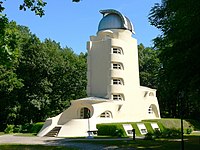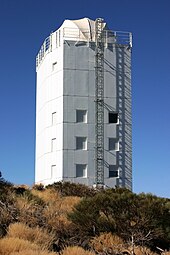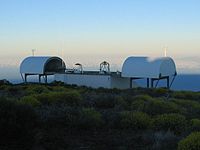
X-ray astronomy is an observational branch of astronomy which deals with the study of X-ray observation and detection from astronomical objects. X-radiation is absorbed by the Earth's atmosphere, so instruments to detect X-rays must be taken to high altitude by balloons, sounding rockets, and satellites. X-ray astronomy uses a type of space telescope that can see x-ray radiation which standard optical telescopes, such as the Mauna Kea Observatories, cannot.

The Large Binocular Telescope (LBT) is an optical telescope for astronomy located on 10,700-foot (3,300 m) Mount Graham, in the Pinaleno Mountains of southeastern Arizona, United States. It is a part of the Mount Graham International Observatory.

Yerkes Observatory is an astronomical observatory located in Williams Bay, Wisconsin, United States. The observatory was operated by the University of Chicago Department of Astronomy and Astrophysics from its founding in 1897 until 2018. Ownership was transferred to the non-profit Yerkes Future Foundation (YFF) in May 2020, which began millions of dollars of restoration and renovation of the historic building and grounds. Yerkes re-opened for public tours and programming in May 2022. The April 2024 issue of National Geographic magazine featured a story about the Observatory and ongoing work to restore it to relevance for astronomy, public science engagement and exploring big ideas through art, science, culture and landscape. The observatory offers tickets to programs and tours on its website.

Astrophysics is a science that employs the methods and principles of physics and chemistry in the study of astronomical objects and phenomena. As one of the founders of the discipline, James Keeler, said, astrophysics "seeks to ascertain the nature of the heavenly bodies, rather than their positions or motions in space–what they are, rather than where they are." Among the subjects studied are the Sun, other stars, galaxies, extrasolar planets, the interstellar medium and the cosmic microwave background. Emissions from these objects are examined across all parts of the electromagnetic spectrum, and the properties examined include luminosity, density, temperature, and chemical composition. Because astrophysics is a very broad subject, astrophysicists apply concepts and methods from many disciplines of physics, including classical mechanics, electromagnetism, statistical mechanics, thermodynamics, quantum mechanics, relativity, nuclear and particle physics, and atomic and molecular physics.

Observational astronomy is a division of astronomy that is concerned with recording data about the observable universe, in contrast with theoretical astronomy, which is mainly concerned with calculating the measurable implications of physical models. It is the practice and study of observing celestial objects with the use of telescopes and other astronomical instruments.

The Pulkovo Astronomical Observatory, officially named the Central Astronomical Observatory of the Russian Academy of Sciences at Pulkovo, is the principal astronomical observatory of the Russian Academy of Sciences. It is located 19 km south of Saint Petersburg on Pulkovo Heights 75 metres (246 ft) above sea level. It is part of the UNESCO World Heritage Site Historic Centre of Saint Petersburg and Related Groups of Monuments. It was formerly known as the Imperial Observatory at Pulkowo.

The Center for Astrophysics | Harvard & Smithsonian (CfA), previously known as the Harvard–Smithsonian Center for Astrophysics, is an astrophysics research institute jointly operated by the Harvard College Observatory and Smithsonian Astrophysical Observatory. Founded in 1973 and headquartered in Cambridge, Massachusetts, United States, the CfA leads a broad program of research in astronomy, astrophysics, Earth and space sciences, as well as science education. The CfA either leads or participates in the development and operations of more than fifteen ground- and space-based astronomical research observatories across the electromagnetic spectrum, including the forthcoming Giant Magellan Telescope (GMT) and the Chandra X-ray Observatory, one of NASA's Great Observatories.

The Berlin Observatory is a German astronomical institution with a series of observatories and related organizations in and around the city of Berlin in Germany, starting from the 18th century. It has its origins in 1700 when Gottfried Leibniz initiated the "Brandenburg Society of Science″ which would later (1744) become the Prussian Academy of Sciences. The Society had no observatory but nevertheless an astronomer, Gottfried Kirch, who observed from a private observatory in Berlin. A first small observatory was furnished in 1711, financing itself by calendrical computations.

Konkoly Observatory is an astronomical observatory located in Budapest, Hungary is part of the Research Centre for Astronomy and Earth Sciences and belongs to the HUN-REN Magyar Kutatási Hálózat. Konkoly Observatory was founded in 1871 by Hungarian astronomer Miklós Konkoly-Thege (1842–1916) as a private observatory, and was donated to the state in 1899. Konkoly Observatory, officially known as HUN-REN CSFK Konkoly Thege Miklós Csillagászati Intézet in Hungarian, is the largest astronomical research institute in Hungary, and hosts the largest telescopes in the country. The Observatory has more than 60 researchers, a quarter of them are non-Hungarian.
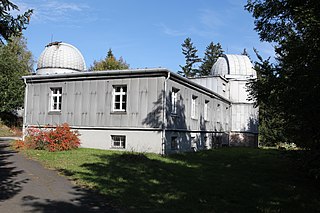
Sonneberg Observatory is an astronomical observatory located at 638 m altitude on Erbisbühl in the Neufang district of Sonneberg. The observatory was founded in 1925 on the initiative of Cuno Hoffmeister by the town of Sonneberg with the support of the Carl-Zeiss-Stiftung. The observatory carries out long-term studies of variable stars. To this end the sky is monitored continuously through photography, resulting in one of the largest archives of astronomical plates. The observatory was also always engaged in popularising astronomy, which now continues in the Astronomy Museum on site.
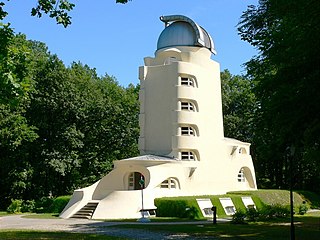
The Einstein Tower is an astrophysical observatory in the Albert Einstein Science Park in Potsdam, Germany built by architect Erich Mendelsohn. It was built on the summit of the Potsdam Telegraphenberg to house a solar telescope designed by the astronomer Erwin Finlay-Freundlich. The telescope supports experiments and observations to validate Albert Einstein's relativity theory. The building was first conceived around 1917, built from 1919 to 1921 after a fund-raising drive, and became operational in 1924. Although Einstein never worked there, he supported the construction and operation of the telescope. It is still a working solar observatory today as part of the Leibniz Institute for Astrophysics Potsdam. Light from the telescope is directed down through the shaft to the basement where the instruments and laboratory are located. There were more than half a dozen telescopes in the laboratory.

The Astronomical Observatory of Rome is one of twelve Astronomical Observatories in Italy. The main site of the Observatory is Monte Porzio Catone. Part of the Istituto Nazionale di Astrofisica since 2002.

The Royal Observatory of Belgium has been situated in the Uccle municipality of Brussels since 1890.

The Shamakhy Astrophysical Observatory, named after Nasreddin Tusi of the National Academy of Sciences of Azerbaijan was established on November 17, 1959, by decree No. 975 of the Council of Ministers of the Azerbaijan SSR. ShAO operates as a research institute within the ANAS Department of Physical, Mathematical, and Technical Sciences. The Observatory is located in the north-east of the Greater Caucasus Range, 150 km from the city of Baku, in the eastern part of Mount Pirkuli, at an altitude of 1435–1500 m above sea level, in geographical coordinates λ = 48⁰ 35' 04" E, φ = 40⁰ 46 '20"N. Here the number of clear nights suitable for observation reaches 150-180 per year.

The Kenwood Astrophysical Observatory was the personal observatory of George Ellery Hale, constructed by his father, William E. Hale, in 1890 at the family home in the Kenwood section of Chicago. It was here that the spectroheliograph, which Hale had invented while attending MIT, was first put to practical use; and it was here that Hale established the Astrophysical Journal. Kenwood's principal instrument was a twelve-inch refractor, which was used in conjunction with a Rowland grating as part of the spectroheliograph. Hale hired Ferdinand Ellerman as an assistant; years later, the two would work together again at the Mount Wilson Observatory.

The Kuffner observatory is one of two telescope-equipped public astronomical observatories situated in Austria's capital, Vienna. It is situated in the West of the city's Ottakring district, on the slope of the Gallitzinberg at 302 m altitude. Originally a private research institution, it was converted into an educational astronomy facility after World War II as buildings and city lights had encroached to a degree that severely hampered scientific nightsky observations. Today the main tasks of the observatory consist in public education on astronomy, operating and preserving the historical equipment, and minor projects in scientific astronomy.

The Albert Einstein Science Park is located on the Telegrafenberg hill in Potsdam, Germany. The park was named after the physicist Albert Einstein. The best known buildings in the park are the Einstein Tower, an astrophysical observatory that was built to perform checks of Einstein's theory of General Relativity; and the Great Refractor of Potsdam, which today belong to the Astrophysical Institute Potsdam. These buildings, along with various astronomical, meteorological, and geophysical observatories were integrated into an English-style country garden.

The Tien Shan Astronomical Observatory is an astronomical observatory located in the Tien Shan Mountains at 2,800 meters altitude, 30 kilometers south of the city of Almaty in Kazakhstan. It was assigned to the Sternberg Astronomical Institute (GAISh) until the collapse of the Soviet Union. The observatory is a state-owned scientific institution that belongs to the Astrophysical Institute after V.G. Fesenkov. It is often used for photometric investigations of variable stars in the Milky Way, eclipsing systems.

Potsdam Great Refractor is an historic astronomical telescope in an observatory in Potsdam, Germany.





